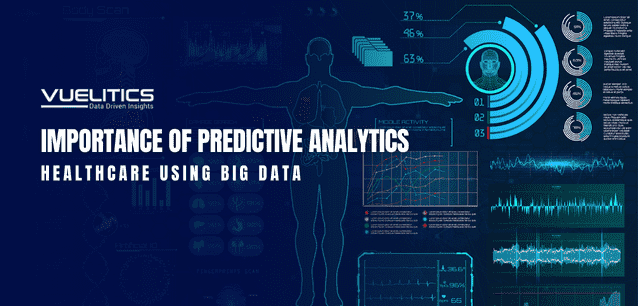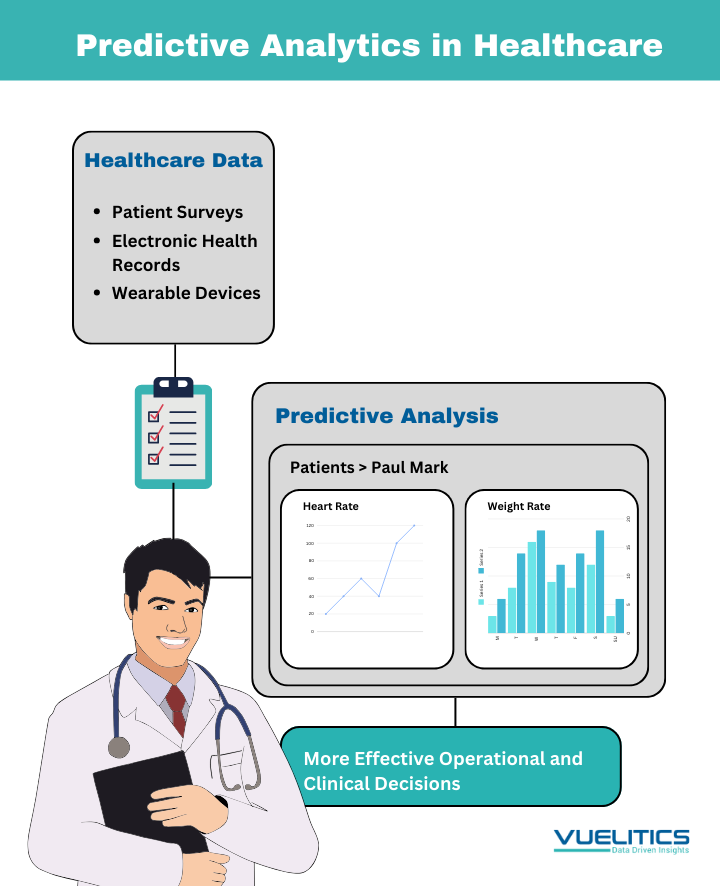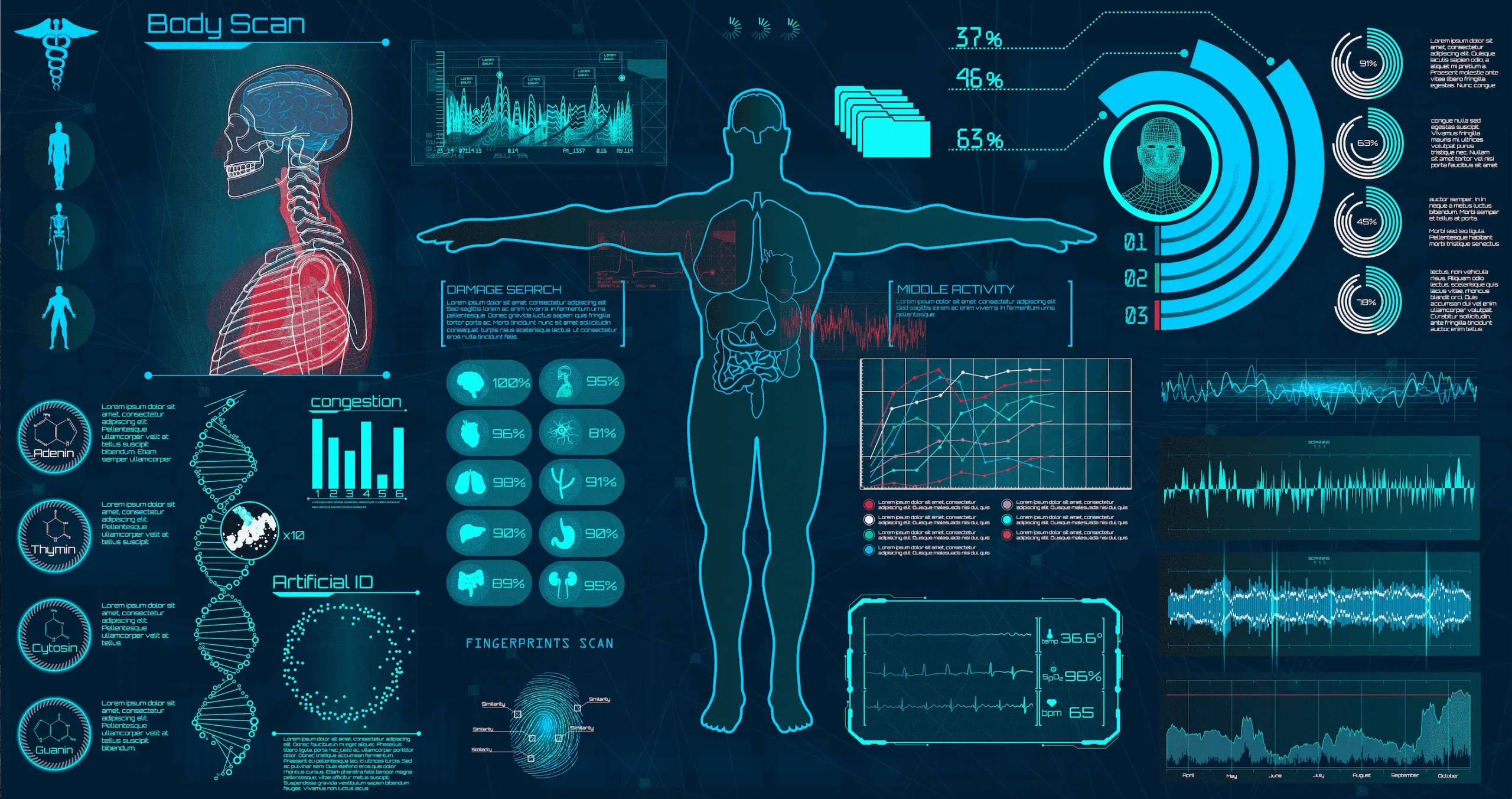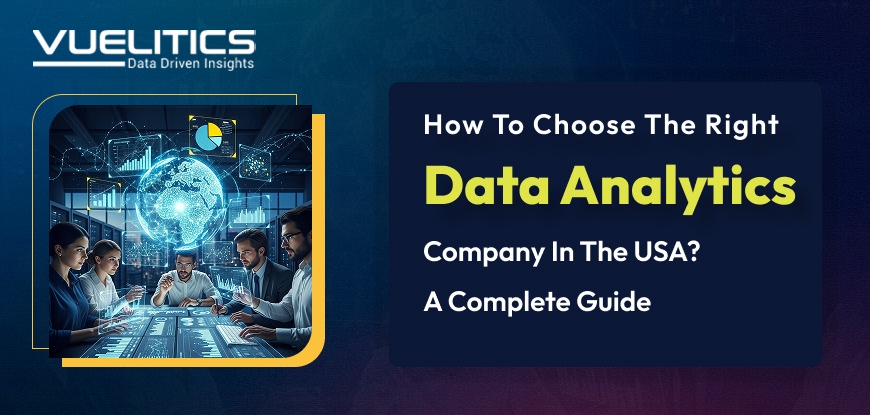- Home
- Blogs

Importance of Predictive Analytics in Healthcare Using Big Data
As someone deeply immersed in the healthcare industry, I’ve witnessed a profound transformation driven by the integration of predictive analytics and big data. The importance of predictive analytics in healthcare using big data cannot be overstated, as it offers unprecedented opportunities to improve patient care, optimize operations, and advance medical research. The vast amounts of data generated daily in healthcare settings provide the foundation for predictive analytics, enabling us to forecast future events based on historical and current data. In this blog, I’ll explore the significance of predictive analytics in healthcare, its benefits, practical applications, and the future of this technology.
The Role of Big Data in Predictive Analytics at Healthcare
Big data refers to the vast and complex datasets generated from various sources, including EHRs, medical imaging, wearable devices, and even social media. This data, when aggregated and analyzed, provides a comprehensive view of patient health and healthcare operations. In my experience, the integration of big data with predictive analytics enhances our ability to make accurate predictions and drive improvements in patient care.
For instance, wearable devices generate continuous streams of data about a patient’s physical activity, heart rate, and sleep patterns. By combining this real-time data with historical health records, predictive models can offer valuable insights into a patient’s overall health and predict potential issues.
Why Data Analytics is Essential in Healthcare?
The necessity of data analytics in healthcare becomes even more apparent when we consider the impact of chronic diseases. Chronic diseases are among the leading causes of death and disability in the USA. Conditions like heart disease, diabetes, and cancer, along with risk factors such as smoking and physical inactivity, have not only been the primary contributors to global morbidity but also exacerbated the severity of COVID-19 outcomes. For instance, individuals with underlying chronic conditions faced a higher risk of severe COVID-19 complications and mortality.
The economic burden of chronic diseases is staggering. By 2030, the global cost of chronic diseases will reach an astonishing $47 trillion. This projection highlights the urgent need for effective interventions to prevent and manage chronic conditions. Data analytics plays a pivotal role here, as it enables healthcare providers to identify at-risk populations, tailor interventions, and track the effectiveness of treatments over time.
Many chronic diseases are preventable or manageable by addressing four major risk factors: physical inactivity, poor nutrition, tobacco use, and excessive alcohol consumption. Predictive analytics, powered by big data, helps us understand the patterns and trends associated with these risk factors, allowing for more targeted and personalized healthcare interventions.
For example, we can identify individuals at high risk for developing chronic conditions by analyzing data from various sources, including electronic health records, wearable devices, and patient surveys. This information allows healthcare providers to intervene early with lifestyle behavior changes and other preventive measures. Moreover, data analytics helps us understand the non-medical factors that influence health, known as social determinants of health. These factors include socioeconomic status, education, and access to healthcare, all of which are critical in the rising rates of chronic disease.
By leveraging predictive analytics, we can develop more effective strategies to address these social determinants, leading to better health outcomes and a reduction in the prevalence of chronic diseases. The integration of big data and predictive analytics into healthcare is not just about treating diseases—it’s about preventing them, improving the quality of life for patients, and ultimately reducing healthcare costs on a global scale.

Benefits of Predictive Analytics in Healthcare
Improved Patient Outcomes
One of the most significant advantages of predictive analytics in healthcare is its ability to improve patient outcomes. By analyzing patient data, healthcare providers can predict the likelihood of diseases, enabling early intervention and personalized treatment plans. For instance, predictive models can identify patients at high risk of readmission, allowing for targeted follow-up care and reducing hospital readmission rates.
Enhanced Operational Efficiency
Predictive analytics can also streamline healthcare operations. By forecasting patient admissions, hospitals can better manage staff schedules, optimize the use of medical resources, and reduce wait times. This efficiency not only enhances the patient experience but also lowers operational costs.
Advancements in Medical Research
The use of big data in healthcare research is revolutionizing the way we understand diseases and develop treatments. Predictive analytics allows researchers to identify patterns in vast datasets, leading to new insights into disease mechanisms and potential therapies. For example, by analyzing genetic data, researchers can predict which patients are more likely to respond to specific treatments, paving the way for personalized medicine.
Cost Reduction
Healthcare costs are a significant concern globally. Predictive analytics helps reduce these costs by minimizing unnecessary tests and procedures, preventing hospital readmissions, and improving overall efficiency. For example, by predicting which patients are likely to develop complications, healthcare providers can take preventive measures, reducing the need for costly emergency interventions.
Practical Applications of Predictive Analytics in Healthcare
Predicting Disease Outbreaks
Predictive analytics is instrumental in anticipating disease outbreaks, as evidenced during the COVID-19 pandemic. By analyzing data from various sources, including social media, travel patterns, and health records, healthcare providers and governments can predict and respond to outbreaks more effectively. This proactive approach helps in allocating resources, implementing preventive measures, and ultimately saving lives.
Personalized Treatment Plans
Every patient is unique, and so are their healthcare needs. Predictive analytics allows for the creation of personalized treatment plans by analyzing an individual’s genetic makeup, lifestyle, and medical history. For example, in cancer treatment, predictive models can help determine which therapies are most likely to be effective for a particular patient, leading to better outcomes and fewer side effects.
Early Detection of Diseases
Early detection is crucial in managing chronic diseases such as cancer and diabetes. Predictive analytics can identify patterns and risk factors in patient data that may indicate the early stages of a disease. By catching diseases early, healthcare providers can implement treatment plans that are more likely to be successful, improving patient prognosis and quality of life.
Optimizing Hospital Operations
Predictive analytics is not just about patient care; it also plays a crucial role in optimizing hospital operations. For instance, by predicting patient admission rates, hospitals can better manage their resources, ensuring that they have the necessary staff and equipment to meet patient needs. This optimization leads to better patient care, reduced wait times, and lower operational costs.

The Future of Predictive Analytics in Healthcare
As we look to the future, the role of predictive analytics in healthcare is set to expand even further. With advancements in artificial intelligence (AI) and machine learning, predictive models will become more accurate and sophisticated, enabling even more precise predictions. These technologies will allow healthcare providers to analyze larger datasets in real-time, leading to faster and more data-driven decision-making.
Moreover, the integration of wearable technology and mobile health applications will provide healthcare providers with real-time data on patients’ health, further enhancing the predictive capabilities of analytics. For instance, wearable devices can monitor vital signs, activity levels, and other health metrics, allowing for continuous monitoring and early detection of potential health issues.
Additionally, the use of predictive analytics in genomics is poised to revolutionize personalized medicine. By analyzing an individual’s genetic data, healthcare providers can predict their risk of developing certain diseases and tailor preventive measures accordingly. This approach has the potential to significantly reduce the prevalence of genetic disorders and improve overall population health.
However, the widespread adoption of predictive analytics in healthcare is not without its challenges. Data privacy and security are major concerns, as the use of big data involves the collection and analysis of sensitive patient information. Ensuring that this data is protected from breaches and misuse is critical to maintaining patient trust and the integrity of healthcare systems.
Furthermore, there is a need for standardized protocols and regulations governing the use of predictive analytics in healthcare. As the technology continues to evolve, it is essential to establish guidelines that ensure the ethical use of predictive models and prevent potential biases in decision-making.
Despite these challenges, the future of predictive analytics in healthcare is undoubtedly promising. As technology continues to advance, it will play an increasingly vital role in improving patient care, reducing healthcare costs, and advancing medical research. By harnessing the power of big data and predictive analytics, we can create a healthcare system that is more efficient, effective, and responsive to the needs of patients.
Conclusion
The importance of predictive analytics in healthcare using big data is evident in its ability to transform patient care, optimize operations, and drive medical research. By leveraging predictive analytics, healthcare providers can anticipate and prevent diseases, improve patient outcomes, and reduce costs. As we continue to embrace this technology, we can look forward to a future where healthcare is not just reactive, but proactive—focused on prevention, personalized care, and continuous improvement. The integration of big data and predictive analytics is not just a trend; it’s a revolution in how we approach healthcare, offering the potential to significantly improve the health and well-being of populations worldwide.
Unlock the full potential of your healthcare data. Explore our Business Intelligence and Data Analytics services and see how we can help you drive better outcomes and optimize operations today.



Post Comments